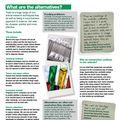Text to go here...
 What is wrong with animal experiments? asks BUAV's new ‘guide for students' and it is a question worth asking. The trouble is that the answers that the guide provides don't seem to have very much to do with the science.
What is wrong with animal experiments? asks BUAV's new ‘guide for students' and it is a question worth asking. The trouble is that the answers that the guide provides don't seem to have very much to do with the science.
From the first page it is clear that the British Union for the Abolition of Vivisection is less interested in a serious exploration of a difficult and complex subject than in giving the facts an emotional spin that seems calculated to mislead young people.
We are told, for example, that animals are ‘poisoned, starved, deprived of water, subjected to electric shocks or invasive surgery, or infected with deadly disease' and if that isn't bad enough, that in‘ two thirds of all experiments, no anaesthetic is used'. But why is a no anaesthetic used?
The guide doesn't bore us with such minor details. We are left to assume that scientists just like seeing animals in pain. The fact that the law insists that anaesthetic cannot be used when administering it would cause more distress than the procedure itself is not mentioned. The authors claim to be familiar with the Animals (Scientific Procedures) Act (there isn't much evidence they have actually read it), so we must assume they are being economical with the truth.
From this disappointing start things only get worse. The rest of the eight-page guide mixes up half-truths, inconsistency, non-sequitur and conjecture in a way that will be familiar to anyone who has come across BUAV's writings on animal research before. Their arguments boil down into the familiar claims that that animal research has no scientific validity and can easily be replaced with alternatives, no matter what the scientists themselves and at least four major independent inquiries think.
So why does animal research still take place? The guide's authors have an opinion, or rather a ‘belief' about this, although they don't say how they came to it. It seems that, on the whole, scientists use animals because that is the conventional thing to do and not using them would mean ‘changing how they do their experiments'. Never mind that science by definition is all about discovery and new ways of doing things, convention is apparently what leads universities, pharmaceutical companies and funding agencies around the world, and thousands of scientists, to keep on with what this guide insists is a fantastically expensive way of not getting results.
If all that strikes you as implausible, then join the rest of the scientific community. This guide should be used as a student primer in the useful skill of spotting rhetoric dressed up as fact or as a checklist of every half-baked argument about animal research they are ever likely to meet.
As a serious contribution to a genuinely serious debate, it is worse than useless. It is a pity that a subject of such importance and with so much at stake has been so poorly served by those who claim to have animal welfare most closely at heart.
Last edited: 27 March 2024 10:51



